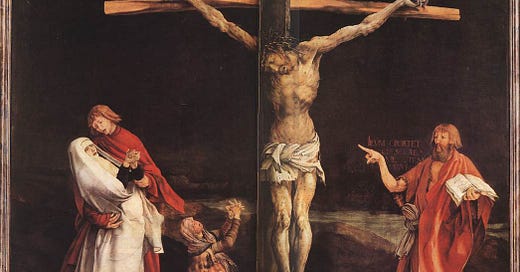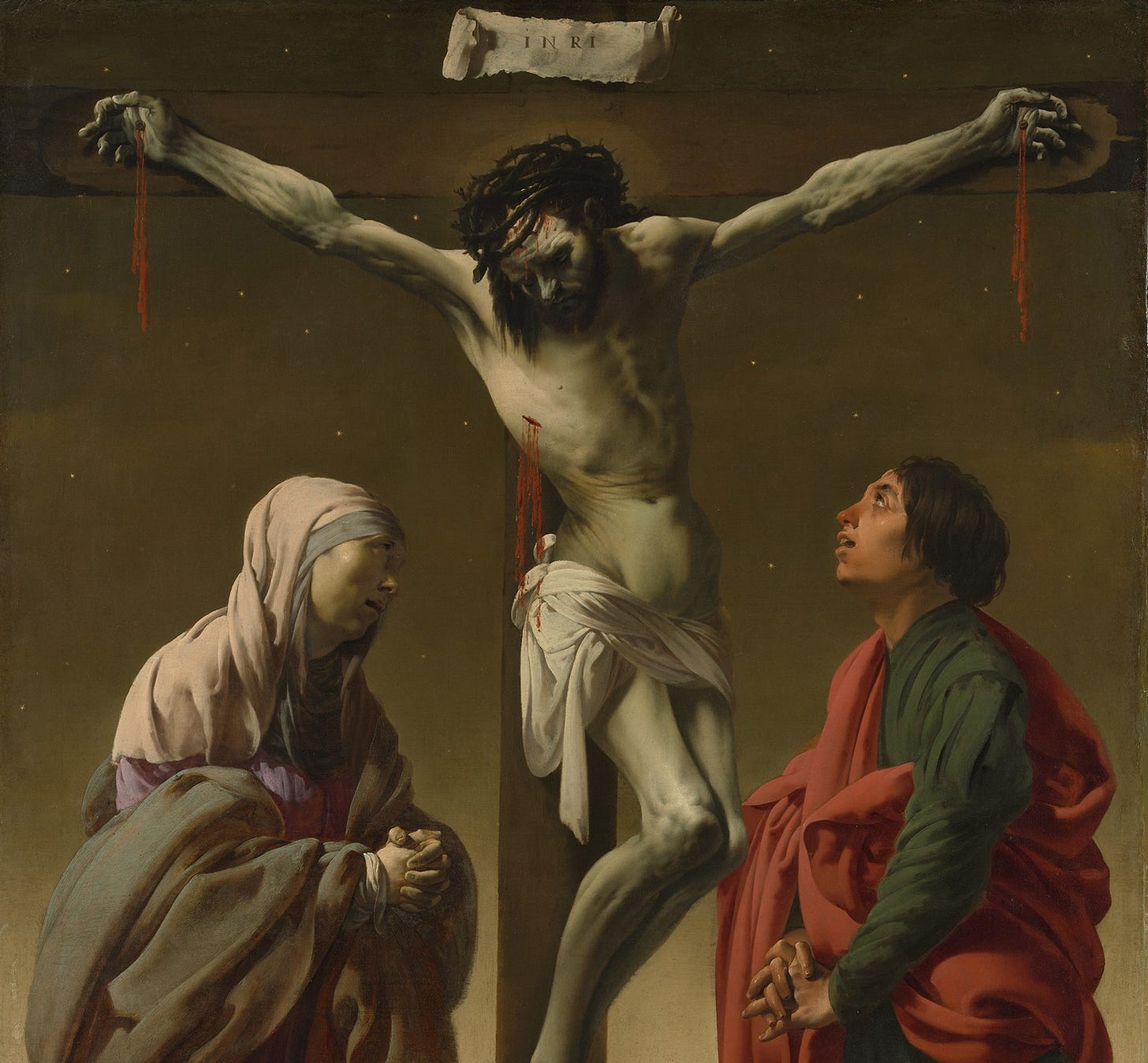On this day Christians around the world pause to remember and reflect on the crucifixion of Jesus Christ. For Anglicans, the Good Friday liturgy brings us face-to-face with our own complicity in Jesus' crucifixion, and it does so with special force in "The Reproaches" where Jesus confronts us as we stand at the foot of the cross. This is the first of six reproaches:
O my people, what have I done to you?
How have I wearied you? Testify against me.
I brought you forth from the land of bondage,
and led you through the waters of salvation,
and you have prepared a Cross for your Savior.
To state the obvious, it seems paradoxical to label the day of our Savior's suffering and death as 'Good Friday.'
To understand the deeper meaning behind this paradox, we can turn to the Gospel of John, chapter 19, where we find ourselves at the foot of the cross once again. The air is thick with sorrow, the sky darkened, and amidst this scene of apparent defeat, we hear the voice of Jesus uttering His final words:
“It is Finished.”
As much or perhaps more than any other statement in the gospels, these final words from the cross demand an explanation. Jesus says, it is Finished, but what is finished? Jesus spoke these words almost 2,000 years ago, and a lot has happened since then. Jesus’ followers are all long-since dead…. most were murdered in one way or another. According to various traditions….
Andrew was crucified
Bartholomew was beaten and then crucified
James, son of Alpheus was stoned to death
James sone of Zebedee was beheaded
John is said to have been boiled in oil but somehow survived and died of old age.
Judas, also called Thaddeus (not Iscariot), was perhaps stoned to death
Matthew was speared to death
Peter was famously crucified upside down
Philip was crucified
Simon was crucified
Thomas was speared to death
Matthias was stoned to death
Whatever was finished on the cross does not appear to have helped Jesus’ followers much. And we could say a great deal more.
The Temple in Jerusalem was destroyed once again, and the Jewish people were scattered about… once again.
The Roman Empire… with all its might….lived on for several centuries, but it too fell to successive waves of barbarian tribes.
Other empires have risen, and most have fallen in turn.
Islam was born and continues to grow in certain parts of the world.
The sun has risen and set more than 700,000 times.
Perhaps 40 billion people have been born between then and now….. more than 30 billion have died.
You get the point. There’s been a lot of water under the bridge since Jesus gave up his Spirit nearly 2000 years ago. The world has moved on, and history keeps rolling along its course, just as it did before the cross.
So back to the question…. what was finished when Jesus said – IT IS FINISHED? What mission was accomplished? What great battle won?
To answer that question… we can look to the book of Revelation. You see, if the gospel of John, chapter 19, ends with a puzzle, John’s apocalypse, and especially chapters 4 and 5, help us put the puzzle pieces back together. John’s apocalypse unveils the mystery of the cross, we might say.
Remember in chapters 2 and 3, John addresses the seven churches of Asia Minor. In chapter 4, the revelation really begins as John has a vision of the throne room of God. To imagine this scene rightly – we should think of a great King ruling his kingdom – sending out envoys, conducting battles, administering justice - all from that throne room. It’s like a great War Room but also much more.
The great throne is surrounded by 24 lesser thrones who rule as stewards and are crowned with glory. We have royal attendants – in this case the four living creatures – the lion, the ox, the eagle, and the one with a face like a man. The whole room is filled with the sounds of hymns and acclamations.
And of course… John uses images from the Old Testament throughout.
God on a throne – from 1 Kings 22, Isaiah 6, and Ezekiel 1.
Having a white appearance – from Daniel 7
Surrounded by beauty – Ezekiel 1
The presence of a sea – Ezekiel 1 and Daniel 7
Fire, smoke, and lightning from Exodus 3, Isaiah 6, Ezekiel 1, and Daniel 7
The living creatures from Ezekiel and Daniel
John makes it very clear that this is a vision of Yahweh’s throne room – and the whole scene is building us up for a revelation of God himself. We expect to see – not just where the power lies – but the one who wields it. And then we come to chapter 5, and things get interesting.
Then I saw in the right hand of him who was seated on the throne a scroll written within and on the back, sealed with seven seals. And I saw a mighty angel proclaiming with a loud voice, “Who is worthy to open the scroll and break its seals?” And no one in heaven or on earth or under the earth was able to open the scroll or to look into it, and I began to weep loudly because no one was found worthy to open the scroll or to look into it. (Revelation 5:1-4)
We expect the one seated on the throne to get all the attention here, but John’s focus turns instead to a scroll, written on both sides and sealed with seven seals. So what is this all about, and why all the weeping? Well… the scroll is like a royal decree. It contains God’s sovereign plan to bring history to its intended conclusion. Scholars are agreed on this point. Joe Mangina writes this…
“Since the ruler in this case is not just any king but the King, the Lord of hosts, then the content of the seven-sealed scroll can be nothing but the divine will. The scroll both symbolizes and embodies God’s intention to execute justice ‘on earth as it is in heaven.’ It entails the setting right of all that is wrong in human history, the defeating of the demonic powers who seek to frustrate God’s purpose, and the establishment of that city in which the horrors of all merely human cities will be overcome.”
So when the Angel asks “who is worthy to open the scroll” he is asking about the Messiah, the one chosen to finally execute and fulfill God’s great battle plan.
John weeps at the angels’ question because no messiah has been found. But then one of the elders speaks up and says in vs. 5 “weep no more; behold the Lion of the tribe of Judah, the Root of David, has conquered, so that he can open the scroll and its seven seals.”
But when John looked up, he saw no Lion – no warrior King at all. Instead, John saw “a Lamb standing as though it had been slain.” Continuing in vs. 7, John writes…
And he (the Lamb) went and took the scroll from the right hand of him who was seated on the throne. And when he had taken the scroll, the four living creatures and the twenty-four elders fell down before the Lamb, each holding a harp, and golden bowls full of incense, which are the prayers of the saints. And they sang a new song, saying, “Worthy are you to take the scroll and to open its seals, for you were slain, and by your blood you ransomed people for God from every tribe and language and people and nation, and you have made them a kingdom and priests to our God, and they shall reign on the earth.” (John 5:7-10)
Revelation 5 is among the most shocking and truly apocalyptic chapters in all of scripture. It blends images that we don’t naturally hold together.
The warrior Lion – in the form of a slaughtered Lamb.
The sovereign power of the Lord of Hosts – demonstrated through suffering and death.
The divine plan finished when Jesus gave up his Spirit and breathed his last.
Eugene Boring writes that Revelation 5 is “perhaps the most mind-wrenching ‘rebirth of images’ in literature.” Richard Hays says
“the shock of this reversal discloses the central mystery of the Apocalypse: God overcomes the world not through a show of force but through the suffering and death of Jesus.”
As the Book of Revelation moves on from chapter 5, we see the work done on the cross play itself out in total victory over Satan and all the forces of evil. In chapter 6, The Lamb begins breaking the seven seals and all the events of the book of revelation unfold – the saints are vindicated, Satan is defeated, and God’s great victory over sin and evil is manifest….. humankind and all of creation is made new.
And John gets to witness all of it. It’s as though God has pulled back the curtain on human history and allowed John to see what really happened on the cross – what it really meant when Jesus said – it is finished.
On the cross of Christ, death itself was swallowed up, meaning that those of us who believe, have nothing to fear from it. Christ has died, Christ is risen, and Christ will come again. As it turns out, Jesus’ final words – IT IS FINISHED - are the foundation of all Christian hope. Former Archbishop of Canterbury, Michael Ramsey, puts it this way:
"The glory of Christianity is that the Lamb slain is the Lord of history. God reigns from the tree."
We know that history rolls on its course. People will be born, and they will die. The sun will rise and set again and again for as long as God wills it to be. But as history rolls on its course – God is collecting all the faithful to himself – all those ransomed by Jesus on the cross are being made imperishable…. prepared for eternal glory in the presence of God.
Whether we live to 25 or 105, our days are infinitesimally short when viewed from the vantage point of eternity. Given this sobering reality, we would do well to ask whether - "it is finished" - sums up our own impending and inescapable deaths? When we die, is that all? Or does Christ's "It is finished" transform the meaning of our own dying?
This Good Friday, as we stand before the slain Lamb who holds history's scroll in his hands, we remember that our brief lives find their meaning not in their duration but in their connection to the One who turned dying into the doorway to eternal life. In Christ, it is not we who are finished - but death itself.
We can be hopeful, especially at the foot of the cross, because Jesus’ redeeming work covers every moment of every day that ever was and ever will be.
Good Friday, 2025







I love where you say, "As it turns out, Jesus’ final words – IT IS FINISHED - are the foundation of all Christian hope." It makes me think about the parallels between resurrection and Sabbath, especially in this context.
I miss your lectures and our conversations! So glad I found this.